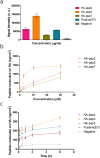Selection and identification of a novel bone-targeting peptide for biomedical imaging of bone
- PMID: 32601412
- PMCID: PMC7324617
- DOI: 10.1038/s41598-020-67522-4
Selection and identification of a novel bone-targeting peptide for biomedical imaging of bone
Abstract
The global burden of bone-related diseases is increasing in the aging society; thus, improved bone targeted imaging for their early identification and treatment are needed. In this study, we screened novel peptide ligands for hydroxyapatite, a major inorganic component of teeth and bones, and identified a peptide enabling in vivo bone targeting and real-time fluorescence bone detection. To isolate peptides highly specific for hydroxyapatite, we used negative and positive selection from a randomized 8-mer peptide phage library and identified hydroxyapatite-specific peptides (HA-pep2, HA-pep3, and HA-pep7). Among these three peptides, HA-pep3 showed the highest binding capacity and superior dissociation constant towards hydroxyapatite surfaces over time (~ 88.3% retained on hydroxyapatite after two weeks). Furthermore, HA-pep3 was highly specific for hydroxyapatite compared to other calcium salt-based materials. Using this superior specificity, HA-pep3 showed higher accumulation in skull, spine, and joints in comparison with scrambled control peptide during real-time whole-body imaging. Ex vivo analysis of the major organs and bone from mice demonstrated that the fluorescence intensity in bone was about 3.32 folds higher in the case of HA-pep3 than the one exhibited by the scrambled control peptide. Our study identified a novel approach for targeting ligands for bone specific imaging and can be useful for drug delivery applications.
Conflict of interest statement
The authors declare no competing interests.
Figures






Similar articles
-
Quantification of the binding affinity of a specific hydroxyapatite binding peptide.Biomaterials. 2010 Apr;31(11):2955-63. doi: 10.1016/j.biomaterials.2010.01.012. Epub 2010 Jan 27. Biomaterials. 2010. PMID: 20106520
-
Poly aspartic acid peptide-linked PLGA based nanoscale particles: potential for bone-targeting drug delivery applications.Int J Pharm. 2014 Nov 20;475(1-2):547-57. doi: 10.1016/j.ijpharm.2014.08.067. Epub 2014 Sep 4. Int J Pharm. 2014. PMID: 25194353
-
Selective drug delivery system to bone: small peptide (Asp)6 conjugation.J Bone Miner Res. 2000 May;15(5):936-43. doi: 10.1359/jbmr.2000.15.5.936. J Bone Miner Res. 2000. PMID: 10804024
-
Synthesis, Characterization, Functionalization and Bio-Applications of Hydroxyapatite Nanomaterials: An Overview.Int J Nanomedicine. 2022 May 2;17:1903-1925. doi: 10.2147/IJN.S360670. eCollection 2022. Int J Nanomedicine. 2022. PMID: 35530974 Free PMC article. Review.
-
Interactions between Clinically Used Bisphosphonates and Bone Mineral: from Coordination Chemistry to Biomedical Applications and Beyond.ChemMedChem. 2018 Feb 20;13(4):289-302. doi: 10.1002/cmdc.201700769. Epub 2018 Jan 30. ChemMedChem. 2018. PMID: 29323467 Review.
Cited by
-
Targeted inhibition of ferroptosis in bone marrow mesenchymal stem cells by engineered exosomes alleviates bone loss in smoking-related osteoporosis.Mater Today Bio. 2025 Jan 21;31:101501. doi: 10.1016/j.mtbio.2025.101501. eCollection 2025 Apr. Mater Today Bio. 2025. PMID: 39944529 Free PMC article.
-
AP-2δ Is the Most Relevant Target of AP-2 Family-Focused Cancer Therapy and Affects Genome Organization.Cells. 2022 Dec 19;11(24):4124. doi: 10.3390/cells11244124. Cells. 2022. PMID: 36552887 Free PMC article.
-
Biomaterials and nanomedicine for bone regeneration: Progress and future prospects.Exploration (Beijing). 2021 Oct 30;1(2):20210011. doi: 10.1002/EXP.20210011. eCollection 2021 Oct. Exploration (Beijing). 2021. PMID: 37323213 Free PMC article.
-
Biomedical applications of solid-binding peptides and proteins.Mater Today Bio. 2023 Feb 15;19:100580. doi: 10.1016/j.mtbio.2023.100580. eCollection 2023 Apr. Mater Today Bio. 2023. PMID: 36846310 Free PMC article. Review.
-
Targeting Agents in Biomaterial-Mediated Bone Regeneration.Int J Mol Sci. 2023 Jan 19;24(3):2007. doi: 10.3390/ijms24032007. Int J Mol Sci. 2023. PMID: 36768328 Free PMC article. Review.
References
Publication types
MeSH terms
Substances
LinkOut - more resources
Full Text Sources
Other Literature Sources
Miscellaneous

